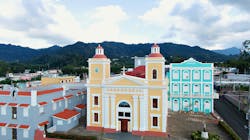In the rural, mountainous regions of central Puerto Rico — which are the first areas to lose power and the last to regain it after storms — young people are leaving because outages undermine their ability to work, stay healthy and enjoy their daily lives.
In four such towns, the Microrred de la Montaña project aims to provide resilience with a microgrid that includes existing and upgraded hydroelectric power, rooftop solar and storage, plus an upgraded distribution network within the boundaries of the towns.
The effort, which will reduce energy costs, lower carbon emissions and keep electricity flowing during and after storms for the municipalities of Adjuntas, Jayuya, Lares and Utuado — home to many disadvantaged residents — aims in part to help ensure that young residents stay local and thrive in their communities.
“Electricity and light give comfort and potential for a better day,” said C. P. Smith, executive director of Cooperativa Hidroeléctrica de la Montaña, an electric cooperative that would own and manage the resources and is working on the project with the Idaho National Laboratory (INL) and Xendee, a California company that offers a microgrid decision support platform. INL recently completed a feasibility study of the project.
The electric cooperative began this project as an outgrowth of disaster relief efforts. While providing medical personnel and supplies after Hurricane Maria, Smith realized that access to electricity is just as important as medical response during disasters. Without electricity and little ability to travel on destroyed roads, dialysis patients could not get access to the services they needed. And when electricity disappeared, residents were without clean water. One healthy 18-year-old died after being exposed to toxins that entered water pipes.
Chain of resiliency
“From there we decided we needed electricity. It’s the beginning and end of a chain of resiliency,” said Smith.
Electricity was important not only for residents’ health but also for the town’s economic activity. To operate a store, residents needed cash registers and lights. Stabilizing the flow of electricity would help stabilize the economy, he said.
As envisioned, the project will incorporate hydroelectricity, solar and storage.
First, the project partners plan to install solar PV and storage on key resources for each community, according to an executive summary of the INL feasibility study. Next, existing hydroelectric facilities would be upgraded and expanded from 6 MW to 50 MW.
Then the Microrred de la Montaña would be created to integrate and manage the resources with energy management and control systems. A new 38-kV transmission line would connect the four towns.
Tim McJunkin, distinguished researcher at INL, said that more use can be made of the heavy rains that storms bring. It’s possible the hydroelectric facilities could be adjusted to handle more rain and generate more electricity.
“If the co-op has more control, we can use more when we have extra rain,” he said. “In anticipating an event we could lower the reservoir and use some of that energy and prepare for that water and use it for storage.”
When the microgrid is installed, the communities will still be connected to the existing electricity system, operated by distribution company Luma Energy, he said. The microgrid would likely benefit Luma Energy and the island’s utility, Puerto Rico Electric Power Authority, by providing grid services.
Payment for the project could come from funds allocated by the U.S. government to Puerto Rico after Hurricane Maria. Those funds are being distributed very slowly, but it’s expected they’ll become more available soon, said McJunkin.
Xendee’s resilience options
The project participants used Xendee’s microgrid design platform to analyze different resilience options, said Michael Stadler, CTO of Xendee. Xendee looked at cost-effective ways to invest in solar PV, batteries and hydropower to meet the communities’ demand, ensuring that either full or partial resiliency is guaranteed.
To achieve partial resiliency, the microgrid would serve critical community infrastructure during outages. With PV and batteries powering the critical loads, the electricity cost savings would be 27.8%, said Stadler. CO2 emissions would be reduced by 47.9% compared to emissions associated with grid power.
Under this scenario, the project would use utility-scale battery storage. The total energy costs would be slightly higher than the partial resiliency scenario, but CO2 emissions would be reduced by 48.1% compared to the towns getting power from the main grid, said Stadler.
To help determine which critical resources would stay powered under the partial resiliency scenario, the mayors of the four towns would meet and identify their priorities, said Smith.
With the communities participating in the project design and ultimately controlling the power through the co-op, residents would have more control — and hopefully decide to stay in town and take advantage of resilient microgrid power.
“The idea is to build resilience and let the communities take control of their own destiny,” said McJunkin.
Track news about microgrid innovation in Puerto Rico. Subscribe to the free Microgrid Knowledge Newsletter.








